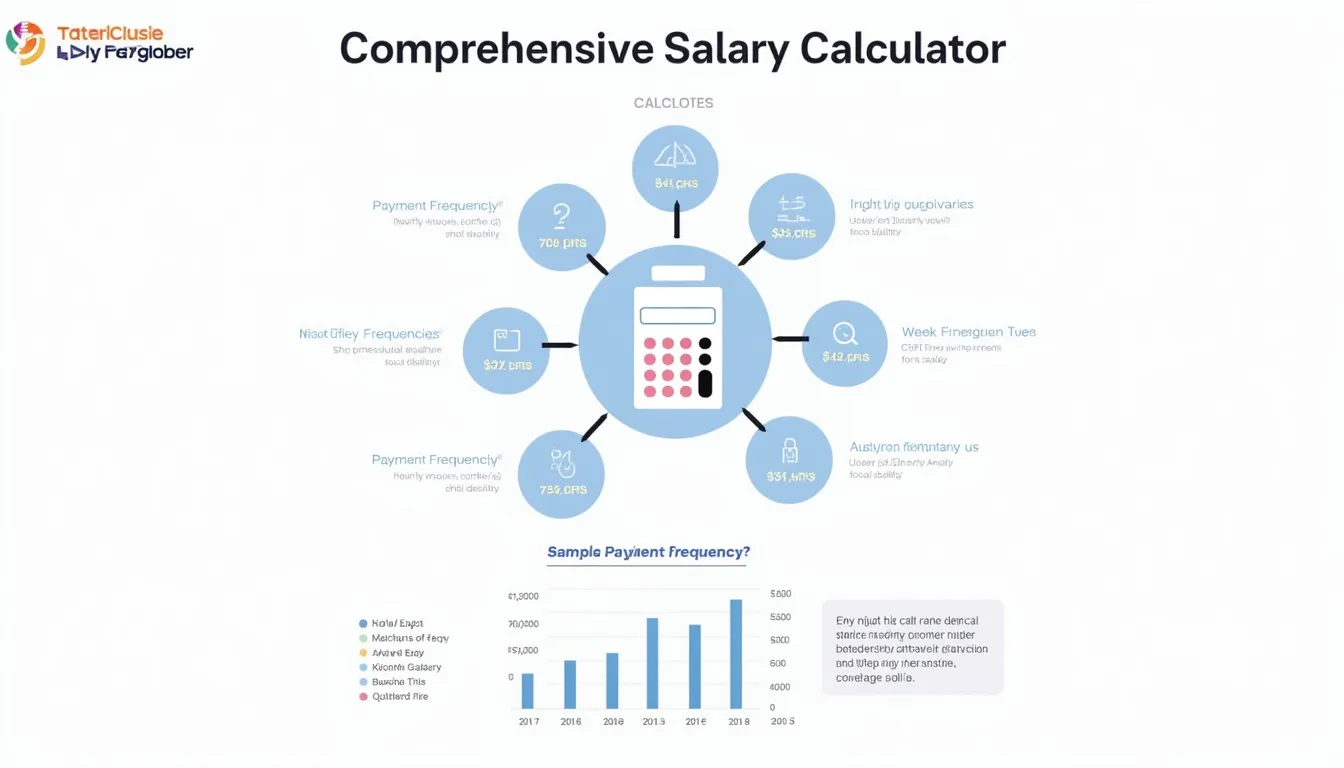Salary Calculator
Is this tool helpful?
How to use the tool
- 1. Salary amount – type your pay, e.g. 47.80 (hourly) or 3,200 (monthly).
- 2. Payment frequency – pick hourly, monthly, etc.
- 3. Hours worked per day – enter 6 or 9.5, not the default 8.
- 4. Days worked per week – try 4 or 6, instead of the usual 5.
- 5. Press “Calculate” – view every equivalent pay period instantly.
Underlying formulas
Let H = hours/day, D = days/week, W = weekly rate.
$$\text{Hourly}\;(\$)=\frac{\text{Weekly}}{H \times D}$$ $$\text{Daily}= rac{\text{Weekly}}{D}$$ $$\text{Weekly}= \begin{cases} \text{Hourly}\times H\times D\\ \text{Daily}\times D \end{cases}$$ $$\text{Bi-Weekly}= \text{Weekly}\times2$$ $$\text{Monthly}= \text{Weekly}\times4.333333$$ $$\text{Quarterly}= \text{Weekly}\times13$$ $$\text{Yearly}= \text{Weekly}\times52$$Worked example A (yearly to others)
- Input – $58,000 yearly, H = 7.5, D = 5.
- Hourly: $$ rac{58{,}000}{7.5\times5\times52}=29.74$$
- Daily: $$ rac{58{,}000}{52\times5}=223.08$$
- Weekly: $$ rac{58{,}000}{52}=1,115.38$$
- Monthly: $$1,115.38\times4.333333=4,833.33$$
Worked example B (hourly to others)
- Input – $32.50 hourly, H = 6, D = 4.
- Weekly: $$32.5\times6\times4=780$$
- Yearly: $$780\times52=40,560$$
- Monthly: $$780\times4.333333=3,380$$
Quick-Facts
- 52 weeks and 4.3333 weeks per month are standard payroll factors (IRS Pub. 15-T, 2024).
- 34.5 average weekly hours for U.S. full-time staff (BLS Table B-2, 2023).
- 72 % of U.S. workers receive bi-weekly pay (American Payroll Association, 2022).
- Median annual U.S. wage: $46,310 (BLS OES, 2023).
FAQ
What does the calculator do?
It converts one pay frequency into six others using fixed time factors and your schedule.
Why multiply weekly pay by 4.333333 for a month?
Because 52 weeks divided by 12 months equals 4.333333, the IRS rounding standard (IRS, 2024).
Can I model a four-day workweek?
Yes—set Days Worked Per Week to 4; all outputs adjust automatically.
Does it include overtime?
No. Add overtime wages to your input, then recalculate for total compensation.
How accurate are annual figures?
They assume 52 paid weeks; unpaid leave reduces real yearly income.
Which pay frequency is most common in the U.S.?
Bi-weekly dominates at 72 % of employers (APA Payroll Survey 2022).
Are the results pre-tax?
Yes. You must deduct federal, state and payroll taxes separately.
Can freelancers use it?
Absolutely—enter your project rate as “weekly” or “monthly” to see hourly equivalents.
Important Disclaimer
The calculations, results, and content provided by our tools are not guaranteed to be accurate, complete, or reliable. Users are responsible for verifying and interpreting the results. Our content and tools may contain errors, biases, or inconsistencies. Do not enter personal data, sensitive information, or personally identifiable information in our web forms or tools. Such data entry violates our terms of service and may result in unauthorized disclosure to third parties. We reserve the right to save inputs and outputs from our tools for the purposes of error debugging, bias identification, and performance improvement. External companies providing AI models used in our tools may also save and process data in accordance with their own policies. By using our tools, you consent to this data collection and processing. We reserve the right to limit the usage of our tools based on current usability factors.







